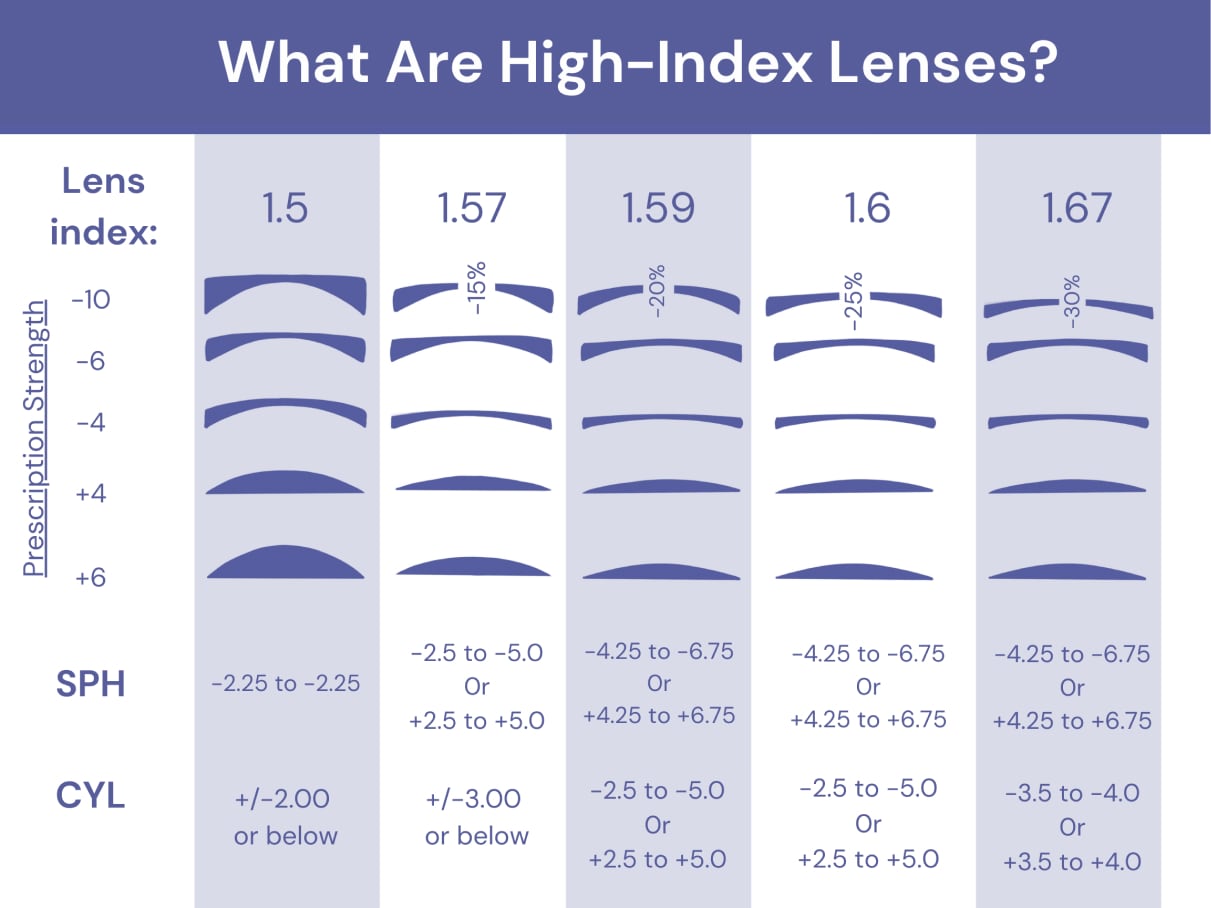Unveiling the Secrets of Modern Optics: What Is a High Index Lens?
Introduction
With innovations and scientific advances in eyewear technology, the concept of high index lenses has come to the foreground. Known for providing sharper vision and sleeker aesthetics, these lenses have gathered a string of followers, particularly amongst individuals with stronger prescriptions. In this comprehensive guide, we will take a closer deep dive into what high index lenses are, how they function, and ascertain whether they are the right choice for you.

What Exactly Is a High Index Lens?
An integral part of modern eyewear, a high index lens signifies a novel approach to correcting vision without compromising on comfort or style. This term may sound sci-fi, but it merely refers to the lens's ability to refract, or bend, light to a significant degree. Here’s the nitty-gritty to aid your understanding:
• The 'high index' Definition: At its core, a high index lens is a type of eyeglass lens that boasts a higher index of refraction. Quite simply, it is adept at bending light more than its traditional counterparts.
• Thinner and Lighter: This increased capacity to manipulate light results in a lens that's substantially thinner and lighter than conventional glass or plastic lenses. It's this gain in portability and wearability which renders high index lenses a popular choice.
• Ideal for Strong Prescriptions: Especially useful for people with stronger prescriptions, such high index lenses efficiently correct vision without adding burdensome weight or bulk to the frames.
• The Aesthetic Angle: Besides functionality, high index lenses bring an aesthetic advantage to the table. By ensuring the lenses don’t 'bulge' out from the frames, they uphold the eyewear's design integrity, thereby enhancing the wearer's overall look.
In essence, high index lenses seamlessly merge the realms of optical science and fashion, delivering a product that caters to both vision correction and style preferences.
Why Have High Index Lenses Become So Popular?
High index lenses have become a modernized trend in the realm of eyewear, enjoying soaring popularity worldwide. Let's unpack the factors that contribute to their charm:
- Sleek Aesthetics: High index lenses are considerably thinner, eliminating the unattractive bulging appearance commonly associated with strong prescription glasses. They easily fit into stylish designer frames, enabling individuals to enjoy the best of both worlds - excellent vision and fashion.
- Enhanced Comfort: Being significantly lighter than conventional glass or plastic lenses, high index lenses afford unique comfort for daily wear. Eye fatigue from prolonged wear is notably reduced, benefitting especially those needing strong prescriptions.
- Superior Optical Clarity: High index lenses offer unrivaled optical clarity, providing a sharper vision than what is achievable with regular lenses. This improvement in visual acuity is particularly noticeable in individuals with high prescriptions.
- Better Peripheral Vision: By curving more closely to the face, high index lenses deliver improved peripheral vision, a point where standard lenses often fail.
The amalgamation of all these elements results in high index lenses’ enormous popularity, primarily amongst individuals with higher prescriptions looking for comfortable yet stylish eyewear.
How Do High Index Lenses Work?
An integral part of discerning the value of high index lenses resides in understanding their functionality. They operate on an innovative optical principle which allows them to offer sharper vision despite being thinner and lighter. Let's dissect how high index lenses work:
1. Index of Refraction: The term 'index' in high index lenses represents the lens’s index of refraction. It measures the lens's ability to bend light. The higher this index, the more a lens can refract or bend light.
2. Efficient Light Bending: High index lenses possess a high index of refraction. Therefore, they can bend light more efficiently than standard lenses. This efficient light bending ability aids in correcting vision using a smaller amount of lens material.
3. Thinner and Lighter Lenses: Due to the effective bending of light, high index lenses require less lens material to correct vision. The result is a thinner, lighter lens providing optimal comfort and a sleek design.
4. Exceptional UV Protection: High index lenses significantly limit the exposure of eyes to the harmful UV rays. The lenses equipped with UV blocking treatment ensure robust protection from harmful sunlight.
5. Combinable with Additional Coatings: High index lenses can be enhanced with several additional treatments. An anti-reflective (AR) coating is a standout — it improves both the visual performance and aesthetics of the lenses. The AR coating reduces glare and reflexes, providing clearer vision and making the lenses appear almost invisible.
In essence, the intuitive approach to light bending and the fewer material constraints make high index lenses a revolution in eyewear technology. With enhanced visual clarity, UV protection, and the possibility to combine with additional coatings, they provide an enriching visual experience.
High Index vs Regular Lenses: What's the Difference?
When comparing high index and regular lenses, we should consider several major differences that can influence which lens type is the best fit for a person's needs. Here's a breakdown of the key distinctions:
1. Thickness and Weight: High index lenses stand out for their thinness and lightness when compared with regular lenses of the same prescription. This quality is due primarily to their higher index of refraction.
- High Index Lenses: Thinner, Lighter
- Regular Lenses: Thicker, Heavier
2. Aesthetics and Comfort: A slimmer profile gives high index lenses a sleek look by preventing them from bulging out of the frames, offering enhanced comfort as they are lighter on the nose bridge and ears.
- High Index Lenses: Sleeker, More Comfortable
- Regular Lenses: Bulky, Potentially Uncomfortable
3. Distortion: High index lenses cause less distortion than regular lenses, offering superior visual quality and clearer peripheral vision.
- High Index Lenses: Less Distortion, Clear Peripheral Vision
- Regular Lenses: More Distortion, Compromised Peripheral Vision
4. UV Protection: High index lenses generally provide better UV protection than regular lenses, an important factor considering the harmful effects of UV radiation on eyes.
- High Index Lenses: Enhanced UV Protection
- Regular Lenses: Standard UV Protection
5. Price: High index lenses are typically more expensive than regular lenses, but this is often offset by the comfort, aesthetics, and superior vision they provide.
- High Index Lenses: Higher Cost
- Regular Lenses: Lower Cost
In choosing between high index lenses and regular lenses, it's essential to balance these factors - thickness, comfort, distortion, UV protection, and price – against each other and against your unique needs and preferences.
Are High Index Lenses the Right Choice for You?
Making the choice of whether high index lenses are suitable for you depends largely on your specific vision requirements, comfort, style preferences, and budget. To help you in your decision-making, here are the pivotal considerations:
1. Vision Prescription: High index lenses are particularly beneficial for those with high prescriptions. If your prescription is strong, these lenses can provide better visual clarity and a more comfortable fit, due to their thin and lightweight design.
2. Comfort and Style: If you desire eyewear that is lightweight and aesthetically pleasing, high index lenses are an optimal choice. Unlike regular lenses that may ‘bulge’ out of the frame, high index lenses offer a slim profile.
3. Budget: While high index lenses may come with a slightly higher price tag than traditional lenses, their benefits of superior vision correction, less distortion, and enhanced aesthetics can justify the investment.
To simplify this further, let’s examine the main pros and cons of high index lenses:
Pros of High Index Lenses:
- Thinner and lighter lenses, ensuring comfortable wear
- Enhanced visual clarity, particularly valuable for individuals with high prescriptions

- Sleek aesthetics with less lens bulging
- Better peripheral vision
- Excellent UV protection
Cons of High Index Lenses:
- Higher initial cost compared to regular lenses
- Potential for more visible reflections, though this can be addressed with an anti-reflective coating
Remember, irrespective of these considerations, it is always recommended to consult with an optician or ophthalmologist before making a final decision. They can guide you on which lens type—either high index or regular—will best cater to your optical needs and lifestyle.
Conclusion
With their thinner, lighter, and more attractive design, high index lenses offer a dynamic solution for those with stronger prescriptions. Though they may be costlier, their superior clarity, greater comfort, and sleek aesthetics validate the price. Always consult with an eye care professional when making your choice.
Related FAQs about what is a high index lens
Why are high index lenses more expensive than regular lenses?
High index lenses are more expensive due to their complex manufacturing process. They are designed to bend light more efficiently, needing less material compared to regular lenses. This improved refractive property involves advanced technology, resulting in a higher cost.
Are high index lenses suitable for people with all levels of prescriptions?
High index lenses specifically benefit those with strong prescriptions as they offer superior visual clarity and lighter weight. However, individuals with lower prescriptions can also use them and enjoy the aesthetic and comfort benefits.
How to properly maintain and clean high index lenses?
To clean high index lenses, use a lens cleaning solution and a microfiber cloth. Avoid harsh cleaners that can damage lens coatings. For maintenance, keep them in a protective case when not in use to prevent scratches and damages.


